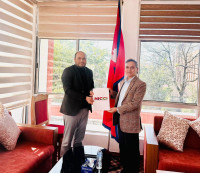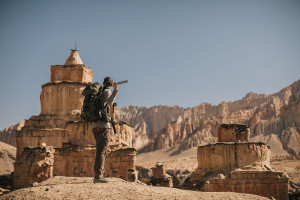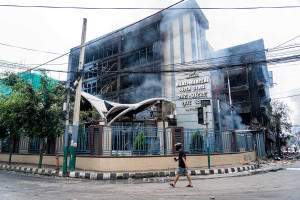Money
The virus strikes back
Nepal’s tourism industry is staring at another year of suspended animation, insiders say.
Sangam Prasain
Coming off the worst years in Nepal's tourism history, there is little optimism in the travel industry that good days will return by the beginning of 2022. Travel experts are now very cautious in their outlook.
The cautious outlook means the travel and tourism business will remain particularly depressed in 2022 with differing levels of border control, quarantine measures and visa procedures that will make international travel difficult, insiders say.
While the brief recovery in October and November had fuelled hopes of a quick recovery for the tourism sector, those hopes were dashed by the winter wave of the pandemic in most of the tourism source markets.
With slowed vaccination rates and new Covid-19 strains, Nepal's tourism industry is staring at another year of suspended animation. Industry insiders are not expecting arrivals to return to pre-pandemic levels before 2023 or 2024.
There are fears that the newly discovered Covid-19 variant Omicron could disrupt global travel once again.
“Like the previous variant, Omicron is not killing people. But this variant is creating a lot of anxiety, globally,” says Basant Raj Mishra, executive chairman of the Temple Tiger Group of Companies, a well-known name in the travel trade community.
“Nepal too will witness this scare sooner or later.”
According to Mishra, he had received a booking for an eight-member high-end group for early January 2022. “They abruptly cancelled the trip. The world is in Omicron scare.”
So far, Nepal has reported three Omicron cases.
The first known confirmed infection of the variant was reported from a specimen collected on November 9, according to the World Health Organisation.
The World Health Organisation said that the Omicron variant of the coronavirus was spreading faster than the Delta variant and was causing infections in people already vaccinated or who had already been infected with other variants.
On September 23, Nepal dumped the seven-day quarantine requirement and resumed issuing on-arrival visas to all vaccinated foreign travellers in a bid to bring its virus-ravaged tourism industry back to life.
Travel and tourism businesses, which accounted for around 8 percent of the country's gross domestic product and provided more than 1.05 million jobs directly and indirectly in pre-Covid days, were the hardest hit after travel restrictions came into force in late March last year.
“We don’t see a full recovery until 2024 because of the new strains developing each passing year. Besides, Nepal’s poor marketing efforts have pushed rebound possibilities further away,” says Ashok Pokharel, president of the Nepal Association of Tour Operators.
When Nepal reopened its doors to tourists in September, travel activity rebounded slightly but remained far below pre-pandemic levels.
According to the Nepal Tourism Board, Nepal welcomed 23,284 foreign tourists by air in October. Arrivals rose slightly to 26,135 in November, the country’s peak tourist season. This is the highest recorded monthly tourist arrivals figure in the post-Covid period.
In total, foreign tourist arrivals by air reached 126,283 in the first 11 months of this year. The figure suggests that international arrivals were down nearly 90 percent in January-November compared to 2019 arrivals.
“The recovery of Nepal’s tourism sector has been going slower than many had anticipated,” said Mishra. “While much has been made in making safe international travel a possibility, we are aware that the crisis is far from over.”
According to Mishra, even as tourists are willing to travel in 2022, they will suffer from a massive price hike. “From air ticket prices to hotel rates, everything is so high and expensive.”
Travel restrictions and an economic slowdown triggered by the Covid-19 pandemic have delivered a massive wallop to Nepal's luxury hotels, decimating revenues and profits, and the dazed hospitality industry is still struggling to recover amid huge losses.
The country’s posh hotels have posted the highest-ever losses in the last fiscal year ended mid-July; and based on the current scenario, mainly tourist arrival figures, the industry could take up to two years or more to return to pre-Covid levels, insiders say.
“The hotel industry has been left in a state of total disarray. It will take years for the sector to recover,” said Binayak Shah, senior vice-president of Hotel Association Nepal. “If there is no new variant, we can expect a speedy recovery within two years. It will depend on the vaccination drive.”
“We have 90 percent vaccinated manpower in the tourism industry, and are confident of being able to serve visitors. But Omicron has emerged as a new spoilsport. It has scared all,” says Shah. “Everything is looking uncertain again.”
Shah said that there were not many bookings for January. “And those booked trips are being cancelled at a fast pace.”
New Delhi, India has been under a night curfew since December 27 after the city registered the highest single-day spike in coronavirus cases since June 9.
“Many cities across the world are imposing lockdowns,” says Shah. “The situation is not in our favour again.”
The travel restrictions brought tourist mobility to an almost complete standstill in the last two years.
Industry insiders say that employment growth is set to be hit next year too.
According to a new report by the World Travel and Tourism Council, domestic travel growth has "significantly" outpaced global tourism as a whole, and is expected to rise even more in 2022.
Nepal is not an exception. “We have to survive in 2022 on domestic tourist movement,” says Mishra.
In the last two years, there has been a massive loss of jobs, particularly in hotels, restaurants and trekking.
Like many countries, Nepal has been doing good to vaccinate people. “We have surplus vaccines but the vaccination drives are slow. Besides, we haven’t seen much commitment from the government to revive the economy,” says Shah.
“Obviously, the government is not serious about reviving the economy. There is no collective effort. The economy is in the doldrums because our country lacks true leadership,” says Mishra. “No one cares how the economy will fare. The year 2022 could be another disaster.”




 10.12°C Kathmandu
10.12°C Kathmandu













%20(1).jpg&w=300&height=200)
